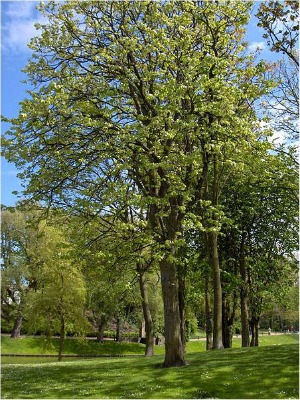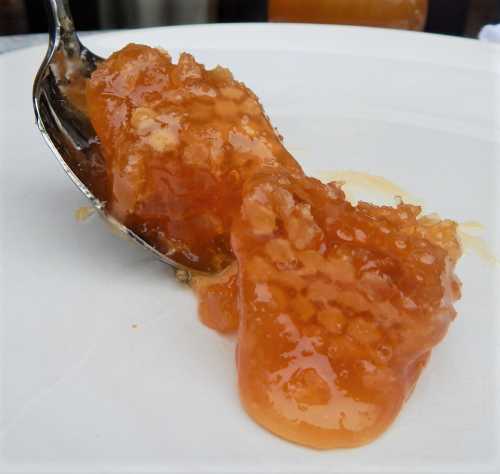Which Lime
Trees Are Toxic For Bees?
Updated: 15th March 2023
Whilst some lime trees (Linden) are toxic for bees, others provide a very useful nectar source.
Reputedly, there are limes (Tilia) which can be foraged on safely by some bee species, whilst they are poisonous for others, or have at least a narcotic/sedative effect.
Bees vulnerable to the sedative characteristics of certain lime trees will obviously be at risk of attack by predators.
If you find dead bees beneath a lime tree, suffice to say, it’s likely you have a poisonous variety, or at least one which has those narcotic effects.
An exception to this could be cases where dead bumble bees have been found beneath a lime tree with parts of the head or abdomen missing.
It is known that Great Tits in particular, will sometimes predate on bumble bees feeding on limes, and will eat the parts of the bumble bee they apparently find most appetizing! This phenomenon can also occur in other settings.
Which Lime Trees Are Safe Or Toxic For Bees?
Some lime trees are favoured by beekeepers, and Linden honey is especially popular in Romania, for example.
Bees may also harvest the honeydew produced by aphids on the leaves.
Lime Trees Thought To Be Safe For Bees
Generally, it
is thought that non-toxic limes are:
- Tilia cordata or Small-leaved Lime (also known as the Small-leaved Linden or Little-leaf Linden). This species is native to Britain, Europe, Scandinavia, and the Caucasus.
- Tilia platyphyllos or Large-leaved
lime (or Large-leaved Linden). It is native to Britain and other
parts of Europe. This species is pictured below (courtesy of Wikipedia).

Which Lime Trees Are Toxic For Bees?
Bumble bees are thought to be particularly vulnerable to certain Limes.
Excerpt from 'A Sting In The Tale' by Professor Dave Goulson (also author of Bumblebee Behaviour And Ecology):
Page 128:
"Buff-tailed and white tailed bumblebees love the flowers of lime trees, although there is something in the nectar which seems to make them dopey and even sometimes kill them".
The following lime trees are regarded as poisonous for bees (or having an unfortunate narcotic effect), and so should be kept out of the bee garden.
- Tilia 'Petiolaris' or Weeping Silver Lime (native to the Balkans)
This is what RHS say about Weeping Silver Lime (post the link in your browser):
http://apps.kew.org/trees/?page_id=131
“Silver lime is a statuesque import from eastern Europe. Bees pollinate the flowers in summer but often die in the process as the nectar is toxic to them. ……......
They are pollinated by bees but as the nectar is toxic to them, you can sometimes find silver lime trees with piles of dozy or even dead bees beneath it.
Indeed, tea made from the flowers of Tilia tomentosa can act as a sedative so the tree clearly has some strong narcotic properties”.
- Tilia euchlora or Caucasian Lime – thought to be a narcotic (i.e. induces a state of sleep of drowsiness – this would increase the vulnerability of bees).
- Tilia tomentosa (Silver Lime
in the UK and Silver Linden in
the US) – especially toxic for bumble bees, but apparently not so toxic for
honey bees.
I would avoid growing this species in the bee garden, since bumble bees will still visit this tree and be poisoned - Tilia dasystila are considered toxic to bees, as are Tilia orbicularis.
- Tilia oliveri (Chinese Lime) is being sold as a pretty garden tree, nevertheless, it is toxic for bees.
Lime trees are said to have a short flowering season.
If you are considering buying lime trees, consider Tilia platyphyllos or Tilia cordata, since it
is generally considered that both of these species of lime trees are safe for foraging
bees. However, space may be an issue!
However I am not even sure it is worth taking a risk with any lime trees in the garden, given that many beautiful flowering trees and shrubs are available.
Why Are Some Linden / Lime Trees Harmful For Bees?
This is as yet unclear. Various theories have been proposed, and later 'debunked' such as mannose content in nectar being responsible1.
Another theory was that some bumble bees simply starve themselves to death by remaining 'loyal' to lime tree nectar (known as 'high nectar resource fidelity'), so that they continue to forage even when the lime tree has stopped producing nectar. It was proposed that the bees then run out of energy and die from starvation before returning back to the nest, but this theory has also been questioned2.
If the theory were correct, why would they not run out of energy when foraging at other plants, and why is it particular to some lime species?
Other research throws doubt on these ideas and it is also suggested that bumble bees are calculated in their assessment of nectar rewards1,3.
A further theory was that deaths in bumble bees occur due to the combination of a low temperature of <30°C and nectar volume, resource fidelity, and alkaloids in nectar1.
However, the authors of the study had already noted that resource fidelity is questionable. Furthermore, are Linden trees really blossoming during dangerously cool temperatures for bumble bees, given that even Tilia tormentosa generally blossoms from June to July? From research I have seen, about 80% of bumble bees in the sample survived after exposure to −5°C for 2 hours4 and bumble bees are fine at temperatures of 15°C.
What About Narcotic Effects?
Previously, I had referred to the effects of drowsiness causing some bees to be vulnerable. I then changed this to accommodate the theory of the founder of toxicology, Paracelsus, which is: "The dose makes the poison".
Having reconsidered, I am reverting back to the original observations from Goulson's book above, and also those originally posted by Kew Gardens prior to the publishing of various studies.
It seems to me that comparisons and investigation of the narcotic effects of nectar in Tilia species merits further investigation.
Effects of 'drowsiness' would explain why some bumble bees are found crawling beneath the trees, whilst others are dead.
Moreover, there may be subtle considerations for researchers.
For example:
- In relation to Tilia cordata, the organisation PFAF5. make the following comment about the flowers:
"If the flowers used for making tea are too old, they may produce symptoms of narcotic intoxication[4]".
I am unable to access the quoted reference to investigate further, but could this statement also apply to the flowers of other Tilia species, including Tilia tormentosa, for example?
Since flowers on any given tree or shrub open at different times and offer varying levels of nectar, this might explain why some Tilias could become increasingly dangerous for bees as the season progresses, and why some flowers even on the same tree may be more dangerous to bumble bees than others at any given time. - Repeatedly, nectars of limes tree blossoms have been shown to demonstrate anxiolytic activity (i.e. cause sedative effects), including in Tilia tormentosa6,7.
It has been shown that crawling bees could be revived with more Tilia nectar, but it would be important to ascertain when the nectar was gathered, the age of the blossoms and from which trees, plus the effects of repeated doses and higher quantities. Is there are a point at which the concentration of sedative properties and quantity of nectar consumed, combine to affect the physical functioning of bees?
- It seems perfectly feasible that Tilia species could vary in the levels anxiolytic activity induced, given the differences in chemical composition of the nectars. The effects on digestive system may also be worth considering.
This could mean that not all lime tree species would effect bumble bees in the same way.
One research paper8 notes:
A study of sedative and anxiolytic effects of silver lime nectar [42] identified constituents of a flavonoid nature with clear anxiolytic effect. Another study on the side effects of anxiolytic drugs has reported digestive problems......
In all tested attributes (antioxidant activity, total flavonoids content, total polyphenols and phenolic acids content), our results indicate that the highest values were presented in the flowers of the silver linden (T. tomentosa).
Why would dangerous Tilia species appeal to bumble bees but not honey bees?
It appears that dead honey bees are infrequently found beneath Tilia trees and that Tilia tormentosa is primarily foraged on by bumble bees.
Why this is the case is not clear. However, it is notable that flowers may be attractive to some bee species, yet are ignored by others.
For example, whilst bumble bees will visit borage flowers, they have been found to be more attractive to honey bees, whilst Lavender is more frequently visited by bumble bees9,10.
Did You Know?
Toxic Honey Was Used In Ancient Warfare!

References
1. Lande C, Rao S, Morré JT, Galindo G, Kirby J, Reardon PN, et al. (2019) Linden (Tilia cordata) associated bumble bee mortality: Metabolomic analysis of nectar and bee muscle. PLoS ONE 14(7): e0218406. https://doi.org/10.1371/journal.pone.0218406
2. Koch H, Stevenson PC. Do linden trees kill bees? Reviewing the causes of bee deaths on silver linden (Tilia tomentosa). Biol Lett. 2017;13.
3.Pyke GH. Optimal foraging in bumblebees: rule of movement between flowers within inflorescences. Anim Behav. 1979;27: 1167–1181.
4. Owen EL, Bale JS, Hayward SAL (2013) Can winter-active bumblebees survive the cold? Assessing the cold tolerance of Bombus terrestris audax and the effects of pollen feeding. PLoS ONE 8(11): e80061
5. Tilia cordata Small Leaved Lime, Littleleaf linden PFAF Plant Database.
6. Arianna Allio, Chiara Calorio, Claudio Franchino, Daniela Gavello, Emilio Carbone, Andrea Marcantoni, Bud extracts from Tilia tomentosa Moench inhibit hippocampal neuronal firing through GABAA and benzodiazepine receptors activation, Journal of Ethnopharmacology, Volume 172, 2015, Pages 288-296, https://doi.org/10.1016/j.jep.2015.06.016.
7. H. Viola, C. Wolfman, M.Levi de Stein, C. Wasowski, C. Peña, J.H. Medina, A.C. Paladini, Isolation of pharmacologically active benzodiazepine receptor ligands from Tilia tomentosa (Tiliaceae), Journal of Ethnopharmacology, Volume 44, Issue 1, 1994, Pages 47-53, ISSN 0378-8741,
https://doi.org/10.1016/0378-8741(94)90098-1.
8. Ražná, K.; Žiarovská, J.; Ivanišová, E.; Urbanová, L.; Harenčár, Ľ.; Kováčik, A.; Kučka, M.; Hrubík, P. Flowers Characteristics of Selected Species of Lime-Tree (Tilia spp.) in Terms of miRNA-Based Markers Activity, Mannose Expression and Biological Compounds Content. Forests 2021, 12, 1748. https://doi.org/10.3390/f12121748
9. Quantifying variation among garden plants in attractiveness to bees and other flower-visiting insects’, Functional Ecology, (October 2013). Functional Ecology is a journal of the British Ecological Society.
10. ‘Longer tongues and swifter handling: why more bumble bees (Bombus spp.) than honey bees (Apis mellifera) forage on lavender (Lavandula spp.)’, Balfour, N. J.; Garbuzov, M.; Ratnieks, F. L.W., in Ecological Entomology (online).
If you found this page helpful or interesting, I'd really be grateful if you would share it with others - if not this page, perhaps another, such as Gardening For Bees.
Thank you so much :) .